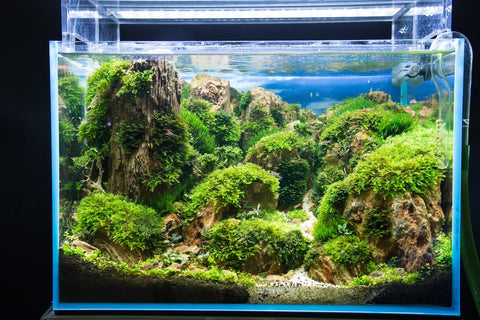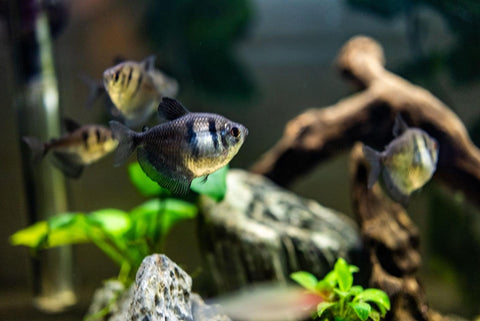Aquascaping is a fascinating and creative art form that deals with the design of impressive underwater landscapes. It is a harmonious combination of aquaristics and garden design in which a unique and aesthetically pleasing underwater world is created.
Aquascaping involves using various elements such as plants, stones, roots, sand and water to recreate a natural environment. The aim is to create a small ecosystem in which plants, fish and other aquatic creatures live together in harmony.
The history of aquascaping
The origins of aquascaping can be traced back to the 19th century, when the first aquariums were set up with plants and small fish. At that time, the design options were limited, as technology and knowledge of aquariums were not yet very advanced.
It was not until the 1930s that aquarists in Japan began to develop aquascaping as an art form in its own right. They experimented with different materials and techniques to create breathtaking underwater landscapes. Through their efforts, aquascaping became increasingly popular and gained recognition.
The term 'aquascaping' was only coined in the 1980s, however, when aquarium design was established as a discipline in its own right. Since then, aquascaping has developed into an internationally recognized art form and there are regular competitions and exhibitions where the most beautiful and creative underwater landscapes are presented.
The advantages of aquascaping
Aquascaping not only offers aesthetic benefits, but also many other positive aspects. Here are some of them:
- Aesthetics: Aquascaping allows you to create an aesthetically pleasing and impressive underwater landscape that will inspire you and others.
- Relaxation: Observing the calm and harmonious life in an aquascape can have a calming and stress-relieving effect. It is a way to escape the stress of everyday life and find peace.
- Biological balance: By carefully selecting plants and animals and providing the right care, you can create a stable and healthy underwater ecosystem.
- Creativity: Aquascaping offers you the opportunity to use your creative skills and realize your individual vision of an underwater landscape. You can use different materials and techniques to create a unique aquascape.
- Education: Aquascaping is a practical way to learn more about nature, the needs of plants and animals, ecology and water chemistry. It can be an inspiring and educational experience.
Tips for aquascaping
If you want to get started with aquascaping, here are some tips that can help you:
- Planning: Think about the design and style of your underwater landscape in advance. Take into account the space you have available and choose plants and materials that harmonize well with each other.
- Choosing the right plants: Find out about the needs of the plants you want to use. Pay attention to the light intensity, nutrient requirements and growth rate. Choose plants that work well together and support the desired appearance of the aquascape.
- Choosing the right materials: Choose stones, roots and substrate that match your design and replicate a natural environment. Make sure that the materials are aquarium-safe and cannot release any harmful substances.
- Lighting: Choose the right lighting for your aquascape to promote plant growth. Pay attention to the light intensity and duration to ensure optimum photosynthesis.
- Care and maintenance: Regular care is important to keep your aquascape healthy and attractive. This includes pruning plants, removing algae, changing the water and monitoring the water quality.
- Patience: Aquascaping requires patience and perseverance. It may take some time for your aquascape to fully grow in and develop its full beauty. Be patient and enjoy the process of creating and maintaining it.
The importance of aquascaping for nature
Aquascaping can not only bring joy to your home or office, but also have a positive impact on nature. By using live plants and creating a natural ecosystem, you can contribute to the preservation of biodiversity.
Plants in the aquascape produce oxygen and help to improve the water quality by breaking down harmful substances. They provide habitat and hiding places for fish and other aquatic life. Aquascaping can also help to maintain the balance in the aquarium by absorbing excess nutrients and reducing algae growth.
By recreating the natural environment in the aquascape, you create an oasis for plants and animals that are endangered or rare in their natural environment. Aquascaping can therefore contribute to species conservation and raise awareness of the beauty and importance of our natural water resources.
Aquascaping as a creative form of expression
Aquascaping gives you the opportunity to express your creative side and create a unique work of art. You can use different styles and techniques to realize your individual vision of an underwater landscape. From minimalist layouts with clean lines to lush and dense aquascapes, there are endless possibilities to unleash your creativity.
You can also add other decorative elements such as stones, roots, figures or small sculptures to your aquascapes to create an additional aesthetic effect. The combination of plants, animals and decorative elements opens up endless design possibilities and allows you to add your own personal touch to your aquascape.
Another aspect of creative expression in aquascaping is the ability to design different types of aquariums, such as nano aquariums, paludariums or wabi kusa tanks. Each style has its own challenges and charms and offers you the opportunity to develop your skills and knowledge.
The challenges of aquascaping
Although aquascaping is a rewarding and inspiring art form, it also comes with some challenges. The care and maintenance of an aquascape requires time, patience and attention. You need to look after the needs of the plants and animals, monitor the water quality and make adjustments if necessary.
Choosing and combining the right plants and materials requires knowledge and experience. It may take some trial and error before you achieve the desired look and balance in your aquascape.
It is also important to choose the right lighting and filtration to promote plant growth while ensuring a healthy environment for fish and other aquatic life.
As with any creative activity, it is important to be open to learning and development. Take part in aquascaping forums and groups, visit exhibitions and events and exchange ideas with other aquascapers to expand your knowledge and skills.
The most important facts at a glance
Aquascaping is a fascinating art form that allows you to bring the beauty of the underwater world into your home or office. It offers aesthetic benefits, promotes relaxation, provides educational opportunities and contributes to the conservation of nature. By designing and maintaining an aquascape, you can use your creative skills to create a unique work of art.
Be ready for the challenges that aquascaping brings and enjoy the process of learning and personal development. Immerse yourself in the fascinating world of aquascaping and give free rein to your creativity!




Comments (0)
There are no comments for this article. Be the first one to leave a message!